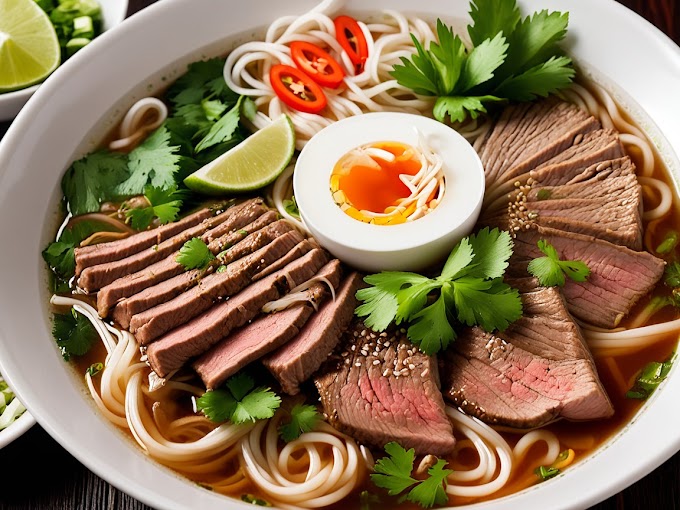Japanese Ramen
Introduction
Ramen is a quintessential Japanese dish that has gained immense popularity worldwide. With its origins in Chinese wheat noodles, ramen has evolved into a unique culinary experience, featuring a flavorful broth, chewy noodles, and an array of toppings. This versatile dish allows for endless variations, but the heart of any great ramen lies in its broth, which can be rich and savory or light and refreshing. The perfect bowl of ramen is a balance of flavors and textures, providing a comforting and satisfying meal.
Ingredients (Serves 4)
For the Broth
- 8 cups chicken broth (or a combination of chicken and pork broth)
- 1 onion, halved
- 4 cloves garlic, smashed
- 1-inch piece of ginger, sliced
- 2 tablespoons soy sauce
- 1 tablespoon miso paste (optional, for added depth)
- 2 tablespoons sake (or dry white wine)
- 2 tablespoons mirin (or sugar, for sweetness)
- Salt, to taste
- Green onions, for garnish
For the Noodles
- 12 ounces fresh or dried ramen noodles (wheat noodles)
For Toppings (Customize as Desired)
- Soft-boiled eggs (marinated in soy sauce for extra flavor)
- Chashu pork (braised pork belly)
- Nori sheets (seaweed)
- Bamboo shoots (menma)
- Corn
- Bean sprouts
- Shredded green onions
- Sesame seeds
Instructions
1. Prepare the Broth
- In a large pot, combine the chicken broth, onion, garlic, and ginger. Bring to a boil, then reduce heat to a simmer.
- Stir in the soy sauce, miso paste (if using), sake, and mirin. Let the broth simmer for about 30–40 minutes, allowing the flavors to meld.
- Strain the broth through a fine-mesh sieve to remove the solids. Return the liquid to the pot and keep warm over low heat. Adjust the seasoning with salt as needed.
2. Cook the Noodles
- In a separate pot, bring salted water to a boil. Add the ramen noodles and cook according to the package instructions, usually 3–4 minutes for fresh noodles or 5–7 minutes for dried noodles.
- Drain the noodles and rinse briefly under cold water to stop the cooking process. Set aside.
3. Prepare the Toppings
- Soft-Boiled Eggs: Bring a small pot of water to a boil. Carefully add the eggs and cook for 6–7 minutes for a runny yolk. Remove and place in ice water to cool. Once cooled, peel the eggs and marinate them in soy sauce for at least 30 minutes.
- Chashu Pork: If using homemade chashu, prepare it ahead of time. Slice thinly and set aside.
4. Assemble the Ramen Bowls
- Divide the cooked ramen noodles among serving bowls.
- Ladle the hot broth over the noodles.
- Top with desired toppings: sliced chashu pork, soft-boiled eggs, nori sheets, bamboo shoots, corn, bean sprouts, shredded green onions, and a sprinkle of sesame seeds.
5. Serve
- Serve the ramen hot, allowing each person to customize their bowl to their liking. Enjoy with chopsticks and a spoon!
Tips for Perfect Ramen
- Broth Depth: For a richer flavor, consider adding dried shiitake mushrooms or kombu (dried seaweed) during the simmering process. Remove before serving.
- Marinated Eggs: Marinate soft-boiled eggs in soy sauce and mirin for an added umami kick. Adjust the marinating time based on your preference for flavor intensity.
- Noodle Texture: Fresh ramen noodles offer the best texture, but if unavailable, look for high-quality dried ramen.
Cultural Background of Ramen
Ramen has its roots in Chinese noodle dishes but has become a symbol of Japanese cuisine. Originally introduced to Japan in the late 19th century, it quickly evolved, with regional variations emerging throughout the country. Today, ramen shops are ubiquitous in Japan, each offering its unique take on the dish. The careful preparation of broth and the attention to detail in toppings reflect the artistry and dedication found in Japanese cooking.
Serving Suggestions
- Accompaniments: Ramen can be enjoyed as a standalone dish or paired with a light salad or steamed vegetables for a complete meal.
- Leftovers: Store any leftover broth and toppings separately from the noodles to maintain texture. Reheat the broth and assemble fresh bowls when ready to eat.
Beverage Pairing
- Japanese Beer: Light beers such as Asahi or Sapporo complement the flavors of ramen without overwhelming them.
- Sake: Serve warm sake for a traditional pairing that enhances the meal.
- Green Tea: A cup of hot green tea offers a refreshing contrast to the richness of the ramen.
Final Thoughts
Japanese Ramen is a delightful dish that showcases the harmony of flavors and textures, making it a favorite comfort food around the world. While it may take some effort to prepare, the satisfaction of slurping a delicious bowl of homemade ramen is well worth it. Gather your ingredients, embrace the art of ramen-making, and enjoy this iconic dish that brings warmth and comfort to any meal!








0 Comments